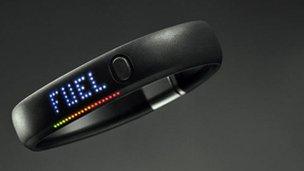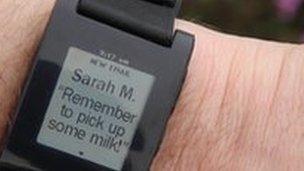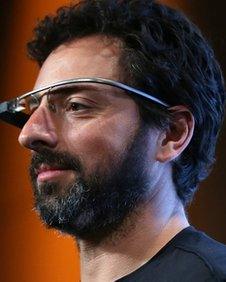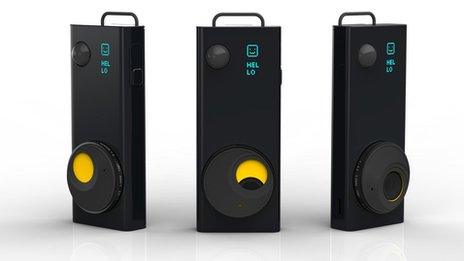Wearable tech pioneers aim to track and augment our lives
- Published

Like many devices, the Nike Fuel Band allows users to see how much energy they burn
A story about a cyclist challenging a policeman over the way he was driving hit the headlines earlier this month.
What was unusual about the case, apart from the obvious role reversal, was the fact that the cyclist had documented the encounter via a camera on his helmet.
Increasingly cyclists are wearing such cameras to record their journeys, using the footage as evidence in the case of accidents.
It has long been predicted that technology would make its way out of our bags and pockets and onto our person and, a quick glance at the way people hug their smartphones and clutch their tablets, shows that there is an appetite among consumers to be ever more closely connected to their devices.
Sport is a natural starting place for wearable tech and cameras, such as the GoPro, have proved a hit with extreme sport enthusiasts keen to record their daring feats.
A device that can constantly update you about how sedentary or otherwise your average day is was the inspiration for another piece of wearable tech released this year by Nike.
Its Fuel Band records a person's movements during the day and synchs with their smartphone, offering a range of data, from the number of calories burned to the number of steps taken.
Anecdotally it has spawned some unusual habits with commuters spotted repeatedly walking up and down stairs at railway stations in order to reach their fuel goals.
Smarter watch
The most hi-tech item most of us currently wear is our wristwatch and they are in the process of getting a whole lot smarter.

The Pebble is one of a new generation of smarter watches
In the spring, Sony launched its SmartWatch. It synched up with Android smartphones and tablets, buzzing when a new call or message was received and allowed users to read mails, texts and updates from Facebook or Twitter directly on the watch face.
Much of the buzz around smart watches went to rival Pebble, a similar device launched on crowd-funding website Kickstarter.
It raised record amounts and the firm, which had originally hoped to get the watch out in time for Christmas, will now ship devices in early 2013, according to the website.
Now it seems Google wants to get involved.
Earlier this month the US patent office approved a filing which describes a concept smartwatch equipped with a camera and a flip-up cover that can display augmented reality information.
There is also a "wireless transceiver" that would allow the watch to connect to wireless networks and a "tactile user interface" for users to talk to their watch.
Augmented view
Google's Terminator-style Project Glass has been arguably the most talked about piece of wearable tech this year.

Google co-founder Sergey Brin is often seen wearing prototype glasses
Project Glass has been a secret initiative for many months and, although the glasses are still not available to the public, they are now being tested by the firm with founder Sergey Brin regularly appearing in public wearing the prototype.
The glasses can record and stream video and display information via a transparent screen just above the wearer's usual line of sight.
They are controlled by voice or via a small touchpad on the device.
"Project Glass is technology that frees you to explore and share your world while keeping you in the moment.
"Technology is at its best when it's available to you at the right time, and otherwise out of your way," a Google spokesman told the BBC.
It is not yet clear what the augmented reality display will show but it is likely to be simple.
"In our testing so far, we've found that micro-interactions like taking a near-instant photo or sharing your first person perspective have been the most compelling," said the spokesman.
Documenting lives
Google's point about technology that can more discreetly record your life is bound to have resonance with the public, even if they are not yet ready to wear special glasses to do it.
How many times have you found yourself at a special occasion only to realise that you have spent the majority of the day behind a lens of your camera or mobile?
Autographer, a wearable camera which can either be clipped to a belt or a handbag or worn on a lanyard around the neck, aims to alter that.
It comes loaded with five sensors which intelligently determine when to take a photos based on changes in light, motion, direction, colour and temperature.
It can take approximately 2,000 pictures a day and has a 136 degree wide angle lens.

The Autographer could be used to document special events
Autographer grew out of a piece of medical equipment designed for Alzheimer patients.
The Revue, jointly developed by the Oxford Metrics Group and the Microsoft Cambridge Lab, was created to allow patients to capture pictures throughout their day and review them with their carers. The hope was that it would work to stimulate short-term memory.
The device captured the attention of photographers who saw the potential for the device to work alongside their traditional SLR cameras.
"They told us that they were using it to get really authentic shots," said Simon Randall, managing director of OMG.
"If you have a hobby and a blog it is a great documenting tool."
Mr Randall has used his to record dinner parties and sees other uses at social events such as weddings or for children to record, say, their first day at school.
"Especially with children, you can get some really candid shots when they don't realise the camera is there," he said.
Wearable technology is still in its infancy but as it increasingly taps into a desire to have the functionality of technology without the intrusiveness, it seems certain to become more mainstream.
- Published28 June 2012
- Published17 April 2012